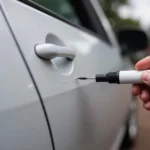Scratches on your plastic car bumper are an unfortunate reality of driving. Whether it’s a minor scuff from a parking lot mishap or a deeper gouge from a more serious incident, knowing how to repair a scratch on a plastic car bumper can save you time and money. This guide will walk you through the process, from assessing the damage to achieving a professional-looking repair.
Fixing a scratch on your car’s plastic bumper often doesn’t require a trip to the body shop. Depending on the severity, you can handle the repair yourself with a few readily available tools and materials. How to repair a scratch on a car plastic bumper is a common search query, and we’re here to provide you with a comprehensive guide.
Assessing the Damage: Light vs. Deep Scratches
The first step in repairing a scratched bumper is determining the extent of the damage. Is it a light surface scratch or a deep gouge that penetrates the plastic? This assessment will determine the appropriate repair method. Light scratches often only require a thorough cleaning and application of a restorative product. Deeper scratches, however, may require filling and sanding before painting.
Repairing Light Scratches
For light scratches, start by thoroughly cleaning the affected area with soap and water. Then, use a plastic cleaner and a microfiber cloth to remove any dirt, grime, or wax residue. Once clean, apply a plastic scratch remover or rubbing compound according to the product instructions. These products are designed to gently abrade the surface, leveling out minor imperfections.
Repairing Deep Scratches
Deep scratches require a more involved repair process. After cleaning the area, you’ll need to fill the scratch with a plastic bumper filler. Apply the filler carefully, ensuring it fills the scratch completely without overflowing. Allow the filler to dry according to the manufacturer’s instructions. Once dry, sand the filled area using progressively finer grits of sandpaper until it’s smooth and flush with the surrounding bumper surface.
Priming and Painting
If the scratch is deep or if the bumper has been previously painted, you’ll need to prime and paint the repaired area. Apply a thin, even coat of plastic primer to the sanded area and let it dry completely. This helps the paint adhere properly. Repair scratched plastic car bumper requires patience and attention to detail to achieve a seamless finish. Next, apply several thin coats of automotive paint that matches your bumper’s color, allowing each coat to dry before applying the next. Finally, apply a clear coat to protect the paint and give it a glossy finish.
Tools and Materials for Plastic Bumper Scratch Repair
Having the right tools and materials is essential for a successful repair. You’ll need:
- Soap and water
- Plastic cleaner
- Microfiber cloths
- Plastic scratch remover or rubbing compound
- Plastic bumper filler (for deep scratches)
- Sandpaper (various grits)
- Plastic primer (for deep scratches and painted bumpers)
- Automotive paint (matching your bumper color)
- Clear coat
- Masking tape and paper
- Putty knife
Car plastic bumper scratch repair can be a DIY project with the proper preparation and materials.
Preventing Future Scratches
While scratches are sometimes unavoidable, you can take steps to minimize the risk. Be mindful of tight parking spaces, avoid parking too close to other vehicles, and consider installing a rearview camera to aid in parking maneuvers. Regularly waxing your bumper can also help protect it from minor scratches.
Conclusion
Knowing how to repair a scratch on a plastic car bumper can save you money and keep your car looking its best. Whether it’s a light scuff or a deeper gouge, how to repair a scratched black plastic car bumper involves assessing the damage, selecting the appropriate repair method, and using the correct tools and materials. With patience and attention to detail, you can achieve a professional-looking repair and restore your bumper to its former glory. Black plastic car bumper scratch repair follows the same principles as any other color bumper repair.
FAQ
- Can I repair a cracked bumper myself?
- What type of paint should I use for a plastic bumper?
- How long does it take for plastic bumper filler to dry?
- Can I use a heat gun to repair a plastic bumper?
- Is it necessary to use primer on a plastic bumper?
- How can I match the paint color to my bumper?
- How can I prevent future scratches on my bumper?
Common Scenarios:
- Light Scratches from Branches: These can often be buffed out with a rubbing compound.
- Scuffs from Parking Lot Mishaps: These may require filling and painting depending on depth.
- Deep Gouges from Impacts: These will always require filling, sanding, priming, and painting.
Further Reading:
Check out our other articles on car maintenance and repair for more helpful tips and advice.
Need Help?
For any assistance or inquiries, please contact us via WhatsApp: +1(641)206-8880, or Email: cardiagtechworkshop@gmail.com. Our customer service team is available 24/7.

